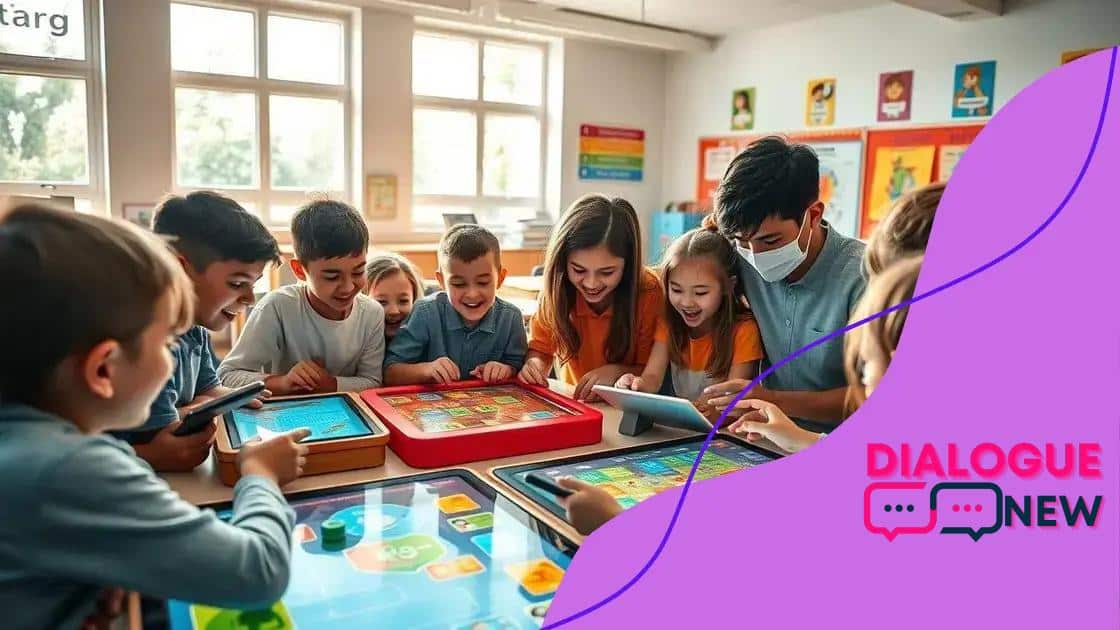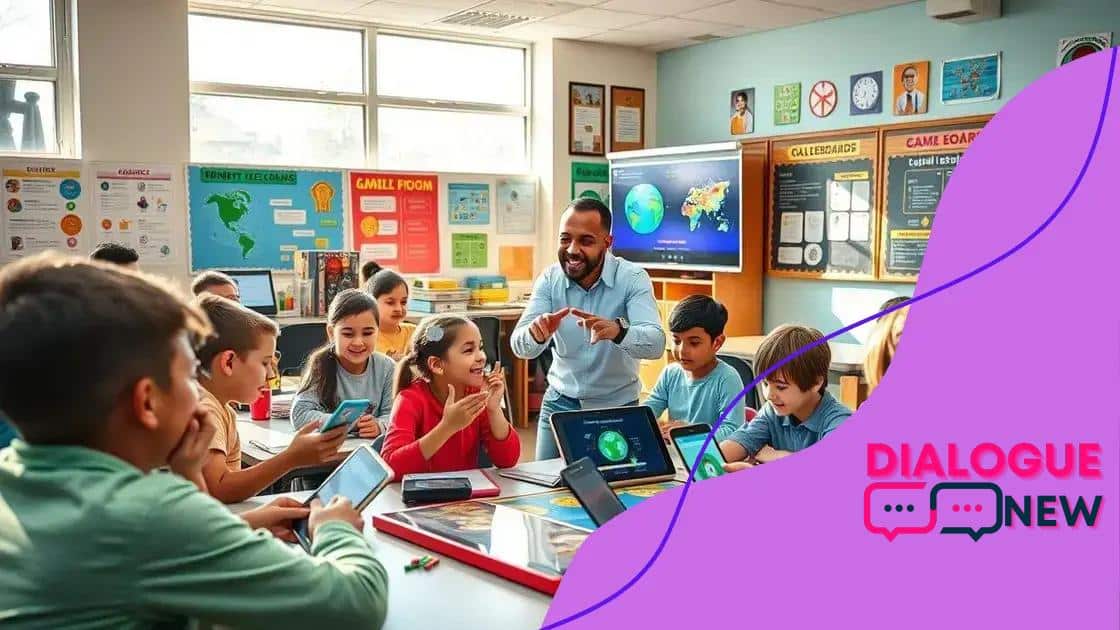Gamification in the classroom for better engagement

Gamification in the classroom enhances student engagement and learning by integrating game elements, using effective strategies, and employing tools that motivate students through competition and collaboration.
Gamification in the classroom transforms traditional learning into an engaging experience. Have you ever thought about how game elements can spark excitement in your students? Let’s dive into how this approach can enhance engagement.
Understanding gamification and its impact
Understanding gamification is crucial in today’s educational landscape. By integrating gaming elements into learning, teachers can foster an environment where students are excited to participate. This approach not only enhances engagement but also makes learning more enjoyable.
Many educators are discovering the impact of gamification. It transforms mundane tasks into challenges that students eagerly tackle. When students feel like they are playing a game, they often put forth more effort and show greater determination to succeed.
What is Gamification?
Gamification involves applying game design principles in non-game contexts. In the classroom, this means using points, badges, leaderboards, and challenges to motivate learners. By creating a game-like atmosphere, teachers can engage students on a deeper level.
Benefits of Gamification in Learning
- Increased motivation and engagement among students
- Enhanced retention of information through interactive learning
- Fostering teamwork and collaboration
- Encouraging healthy competition
This approach not only makes learning fun but also encourages students to take ownership of their education. By setting goals and tracking their progress, they become active participants in their learning journeys. Students can see their achievements visually, which boosts their confidence.
Furthermore, gamification helps address different learning styles. By providing various ways to engage with content, teachers can meet the needs of every student. Some might thrive in competitive settings, while others might prefer collaborative tasks. Understanding these dynamics allows for a more personalized learning experience.
Benefits of gamification in learning
Gamification offers numerous benefits for enhancing student learning experiences. By integrating elements of game design into education, educators can significantly boost engagement. This shift makes learning activities feel less like chores and more like exciting challenges.
One major advantage of gamification is the ability to motivate students. When learners are rewarded with points or badges, they are more likely to remain interested in their studies. This form of recognition encourages them to strive for improvement and achieve their academic goals.
Enhanced Learning and Retention
Gamification has been shown to improve information retention. When students engage with content through interactive and competitive formats, they are more likely to remember the material. By making learning enjoyable, they can absorb concepts deeply and effectively.
Fostering Collaboration
Another benefit is the opportunity to enhance teamwork among students. Working together in groups to complete challenges or earn rewards fosters a sense of community. This collaboration not only helps students develop social skills but also encourages knowledge sharing, making the learning experience richer.
- Increased motivation through immediate feedback.
- Improved course completion rates.
- Encouragement of a growth mindset.
- More opportunities for creativity and critical thinking.
Moreover, gamification can adapt to different learning styles, ensuring that every student finds a way to connect with the material. Whether through competition, cooperation, or creativity, each learner can find their niche and thrive.
By incorporating gamification into the classroom, teachers create a dynamic learning environment. As students progress through levels or earn rewards, they remain engaged and focused, leading to better academic performance and a love for learning.
Strategies for implementing gamification

Implementing gamification in the classroom requires careful planning and understanding. By using effective strategies, teachers can ensure that their approaches maximize student engagement and learning. Each strategy can be tailored to fit the specific needs of students, making the learning experience more relatable and enjoyable.
One effective way to start is by identifying clear learning objectives. Knowing what you want students to learn allows you to design gamified elements that align with those goals. This means you should consider what skills or knowledge you want to assess and then create challenges that reflect these areas.
Incorporating Game Elements
Integrating game elements like points, levels, and badges can significantly enhance participation. When students earn points for completing tasks or reach new levels for mastering concepts, they feel a sense of accomplishment. This competitive yet friendly atmosphere encourages them to engage more deeply with the material.
Creating Challenges and Rewards
Designing challenges that are both fun and educational is essential. You can create group competitions or individual quests that promote collaboration and peer learning. Additionally, providing rewards like virtual badges or certificates for achievements can motivate students. These incentives make the learning process exciting and can lead to improved performance.
- Use storytelling to create an immersive experience.
- Encourage student input in game design for ownership.
- Set up leaderboards to track progress in an engaging way.
- Incorporate technology like apps and online platforms.
It’s also important to gather feedback from students. Understanding what they enjoy or find challenging helps you refine your gamified approach. By listening to their suggestions, you can adapt the strategies to make them even more effective.
Lastly, start small. You don’t need to overhaul your entire curriculum at once. Introduce gamification into a single lesson or unit, and then expand based on students’ reactions and improvements in engagement.
Examples of gamification tools for educators
Gamification tools can transform the classroom by making learning more engaging and interactive. Educators have access to a variety of tools and platforms that enhance the learning experience. These tools not only motivate students but also foster a sense of achievement.
One popular example is Kahoot!. This game-based learning platform allows teachers to create quizzes that students can answer in real-time. The competitive element of earning points keeps students engaged and encourages them to participate actively. Plus, it’s fun to see who can rank at the top of the leaderboard.
Using Classcraft
Classcraft is another innovative tool designed to gamify the classroom experience. It allows students to create their own avatars and work together to complete quests. As they learn, they can earn points to power up their characters. This encourages teamwork and collaboration.
Quizizz for Interactive Learning
Quizizz is a popular platform that resembles Kahoot! but allows students to work at their own pace. Teachers can design quizzes and share them with their class. Students answer questions and receive instant feedback, promoting engagement and understanding.
- Seesaw: A platform for student engagement and e-portfolios.
- Flipgrid: Tool for video discussions and student expression.
- Badged: A tool for rewarding students with digital badges.
Using gamification tools like these can significantly improve student participation. They add an element of fun while reinforcing key concepts. By searching for the right tools, educators can create an engaging and interactive learning environment that caters to diverse learning styles.
As technology continues to evolve, more gamification tools will likely emerge. It’s essential for educators to stay updated and experiment with different platforms to find what works best for their classroom dynamics.
Measuring the effectiveness of gamification
Measuring the effectiveness of gamification in the classroom is essential to understand its impact on student learning. Educators need clear methods to assess whether these strategies are achieving desired outcomes. By evaluating both engagement and learning, teachers can make informed decisions about their teaching approaches.
One effective way to gauge success is through student feedback. Regular surveys or informal discussions can provide insights into what students enjoy and what they find challenging. This feedback helps educators adjust their methods and improve the gamified experience.
Tracking Academic Performance
Another measure of effectiveness involves analyzing academic performance. By comparing grades and assessment scores before and after implementing gamification, teachers can identify trends. Improvement in scores often indicates that gamified methods are positively influencing learning.
Engagement Metrics
Assessing engagement can also be done through tracking participation rates in gamified activities. Teachers can look at attendance, completion rates for tasks, and the time students spend on activities. Higher participation often correlates with increased interest and motivation.
- Use analytics from gamification tools to monitor student progress.
- Conduct pre and post assessments to measure knowledge gained.
- Watch for changes in classroom behavior and participation.
- Analyze the time spent on tasks to gauge interest levels.
Observing classroom dynamics offers additional valuable insights. For instance, increased collaboration among students during gamified activities is a positive sign. When students help each other and work as a team, it indicates that gamification fosters a supportive learning environment.
Finally, reviewing completion and failure rates can help pinpoint what is working and what isn’t. If many students are struggling with specific gamified tasks, it may signal the need for adjustments or additional support.
FAQ – Frequently Asked Questions about Gamification in the Classroom
What is gamification in education?
Gamification in education involves using game elements in the learning process to increase student engagement and motivation.
How can I measure the effectiveness of gamification?
You can measure effectiveness through student feedback, academic performance, and engagement metrics to see how well gamification is working.
What are some popular gamification tools for educators?
Popular tools include Kahoot!, Classcraft, Quizizz, and Seesaw, all of which help make learning interactive and fun.
Can gamification improve collaboration among students?
Yes, gamification encourages teamwork and collaboration by having students work together on challenges and quests.





